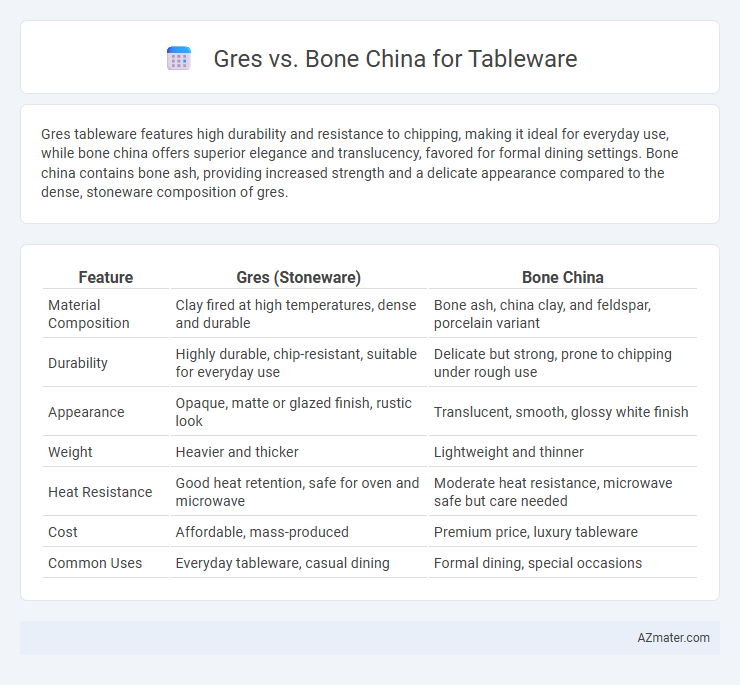Gres tableware features high durability and resistance to chipping, making it ideal for everyday use, while bone china offers superior elegance and translucency, favored for formal dining settings. Bone china contains bone ash, providing increased strength and a delicate appearance compared to the dense, stoneware composition of gres.
Table of Comparison
| Feature | Gres (Stoneware) | Bone China |
|---|---|---|
| Material Composition | Clay fired at high temperatures, dense and durable | Bone ash, china clay, and feldspar, porcelain variant |
| Durability | Highly durable, chip-resistant, suitable for everyday use | Delicate but strong, prone to chipping under rough use |
| Appearance | Opaque, matte or glazed finish, rustic look | Translucent, smooth, glossy white finish |
| Weight | Heavier and thicker | Lightweight and thinner |
| Heat Resistance | Good heat retention, safe for oven and microwave | Moderate heat resistance, microwave safe but care needed |
| Cost | Affordable, mass-produced | Premium price, luxury tableware |
| Common Uses | Everyday tableware, casual dining | Formal dining, special occasions |
Introduction to Gres and Bone China Tableware
Gres tableware, crafted from high-fired stoneware clay, offers exceptional durability and resistance to chipping, making it ideal for everyday use in both residential and commercial settings. Bone china, composed of porcelain with bone ash, is renowned for its delicate translucency, lightweight feel, and refined aesthetic, often used in formal dining and luxury table settings. Both materials provide distinct advantages, with Gres emphasizing robustness and bone china highlighting elegance and fine craftsmanship.
Composition and Material Differences
Gres tableware is made from stoneware clay fired at high temperatures, resulting in a dense, durable material resistant to chipping and thermal shock. Bone china contains bone ash combined with porcelain clay, producing a translucent, lightweight product known for its delicate appearance and high strength-to-weight ratio. The key compositional difference lies in bone china's bone ash content, which enhances whiteness and translucency, while gres emphasizes robustness and everyday practicality.
Manufacturing Processes Compared
Gres tableware is produced through high-temperature firing of natural clays, resulting in a dense, durable ceramic with low porosity and a matte finish. Bone china manufacturing involves blending bone ash with kaolin and feldspar, fired at lower temperatures, yielding a translucent, lightweight, and highly refined porcelain. The key manufacturing distinction lies in gres's robustness suited for everyday use versus bone china's delicate composition favored for elegance.
Durability and Strength Analysis
Gres tableware is known for its exceptional durability and resistance to chipping due to its dense, vitrified composition, making it ideal for everyday use. Bone china offers superior strength relative to other ceramics, combining translucency with high mechanical resistance, although it is more prone to damage under heavy impact compared to gres. The enhanced toughness of gres surfaces outperforms bone china in terms of scratch resistance and thermal shock endurance, ensuring longer lifespan in demanding environments.
Aesthetic Appeal and Design Versatility
Gres tableware offers a rustic, textured aesthetic with earthy tones that enhance casual and contemporary settings, while bone china boasts a refined, translucent finish ideal for elegant and formal dining experiences. The design versatility of gres allows for bold patterns and durable finishes suitable for everyday use, whereas bone china supports intricate detailing and delicate embossments that elevate sophisticated table settings. Both materials cater to different stylistic preferences, balancing durability with visual appeal for diverse dining atmospheres.
Weight and Handling Comfort
Gres tableware typically features a heavier, more robust construction which offers durability but may feel cumbersome during handling. Bone china, known for its lightweight and delicate composition, provides enhanced comfort and ease of use, especially for prolonged dining. The lighter weight of bone china reduces hand fatigue, making it a preferred choice for elegant table settings that prioritize both aesthetics and user comfort.
Heat Retention and Suitability for Different Foods
Gres tableware exhibits superior heat retention due to its dense and porous structure, making it ideal for serving hot dishes like stews and soups that require maintaining warmth. Bone china, while elegant and lightweight, has lower heat retention but offers excellent suitability for delicate foods such as pastries and light salads, preserving their texture without overwarming. Choosing between gres and bone china depends on the dish's temperature demands and presentation style, with gres excelling in heat endurance and bone china prioritizing aesthetic finesse.
Maintenance, Care, and Longevity
Gres tableware, made from dense stoneware clay, offers exceptional durability and resistance to chipping, making it easier to maintain with simple cleaning methods and less frequent replacements. Bone china, composed of bone ash and porcelain, requires more delicate handling to avoid cracks and chips, but its non-porous surface resists staining and retains a pristine appearance with proper care. Both materials benefit from avoiding extreme temperature changes and abrasive cleaners to extend longevity and preserve their aesthetic appeal.
Cost Comparison and Value for Money
Gres tableware typically offers a more affordable price point compared to bone china, making it a cost-effective option for everyday use and bulk purchases. Bone china provides superior durability and a refined, translucent appearance, justifying its higher cost for those seeking luxury and long-term investment. When balancing cost against value, gres appeals to budget-conscious buyers, while bone china delivers enhanced aesthetic appeal and status, reflecting greater value for special occasions.
Sustainability and Environmental Impact
Gres tableware is known for its durability and lower environmental footprint due to the use of natural clays and less energy-intensive firing processes compared to bone china. Bone china production relies heavily on bone ash, often sourced from animal byproducts, and requires higher kiln temperatures, resulting in greater energy consumption and carbon emissions. Choosing gres supports sustainable craftsmanship with reduced waste and longer lifecycle use, making it a more eco-friendly option for environmentally conscious consumers.

Infographic: Gres vs Bone china for Tableware
 azmater.com
azmater.com